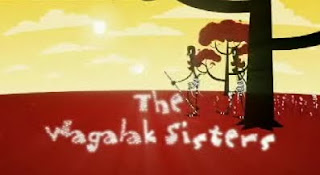Ha ha ha my movie didn't work out the way I wanted. I didn't realise they were going to walk away from each other, and I didn't know how to change the scenario so they actually leave together. This site, unfortunately, is inappropriate for children of any age in an educational setting.
This site however is much better. There are only two characters, which is a little restricting. Their actions and the setting you can put them in are already set out, all you have to do is choose the ones you want. It's a little restricting, but maybe that's a good thing, especially for the little one. The more guidance the better in some cases.
This is the end of my second film. It was created on the ABC's Zimmer Twins site. The little girl dropped her letter in the living room and this is the frame where her brother finds it. http://www.abc.net.au/
This is a great alternative to story writing. The students would still have to go through all the conventional steps necessary to create a story: brainstorming, sorting out their ideas, then producing the first and final drafts. The children would learn and practice all traditional story writing skills, while enhancing their IT skills. Since most children are good with computers, using them would mean more children would enjoy the process (especially those who struggle with literacy). Happy kids learn.
This came off the 'build your wild self' site.http://www.buildyourwildself.com/ The site gives you either a boy or a girl then you can create a little boy/girl/creature. This started off as me, then I realised I looked like a boy, so I made myself into a creature. I'm not quite sure how this would enhance a child's learning experience? It's fun, but it doesn't really offer much room for creativity. You're either a boy or a girl, you chose the hair, eyes etc. Maybe it could be used as a starting point for a story. Maybe? How did they get elephant feet? On the other hand, and experience is an experience.








